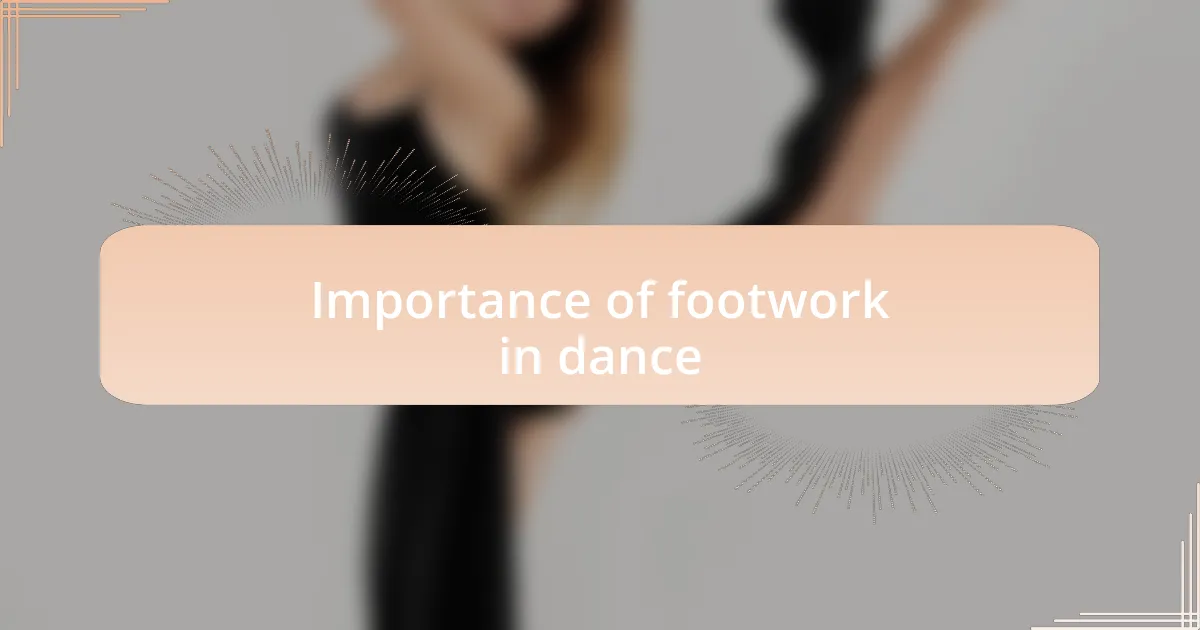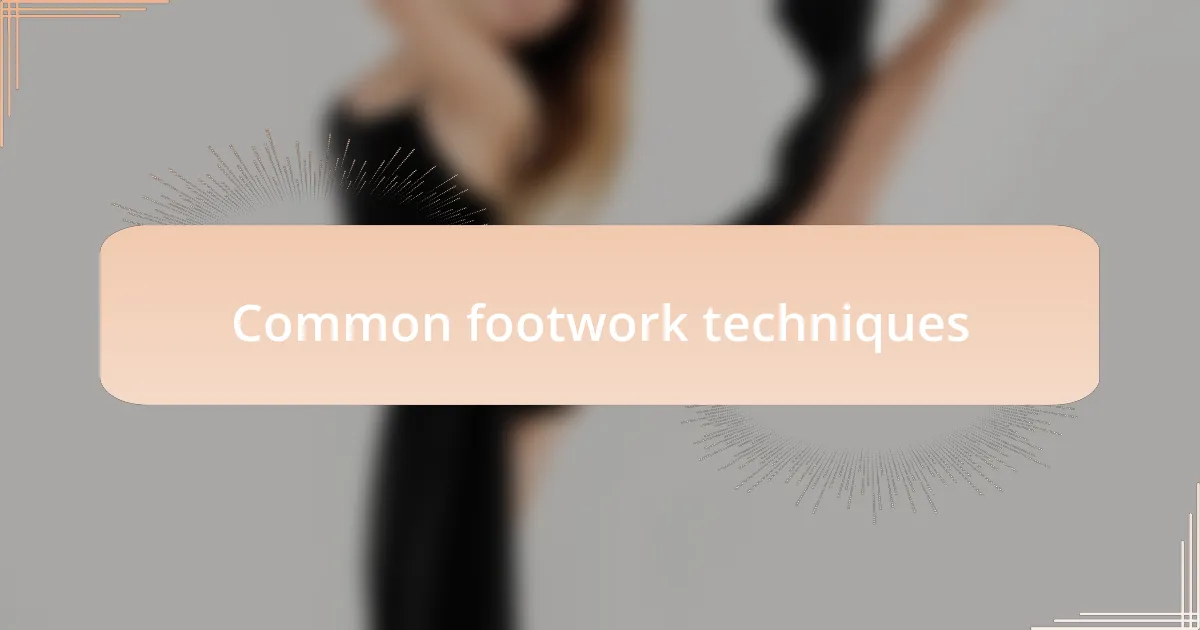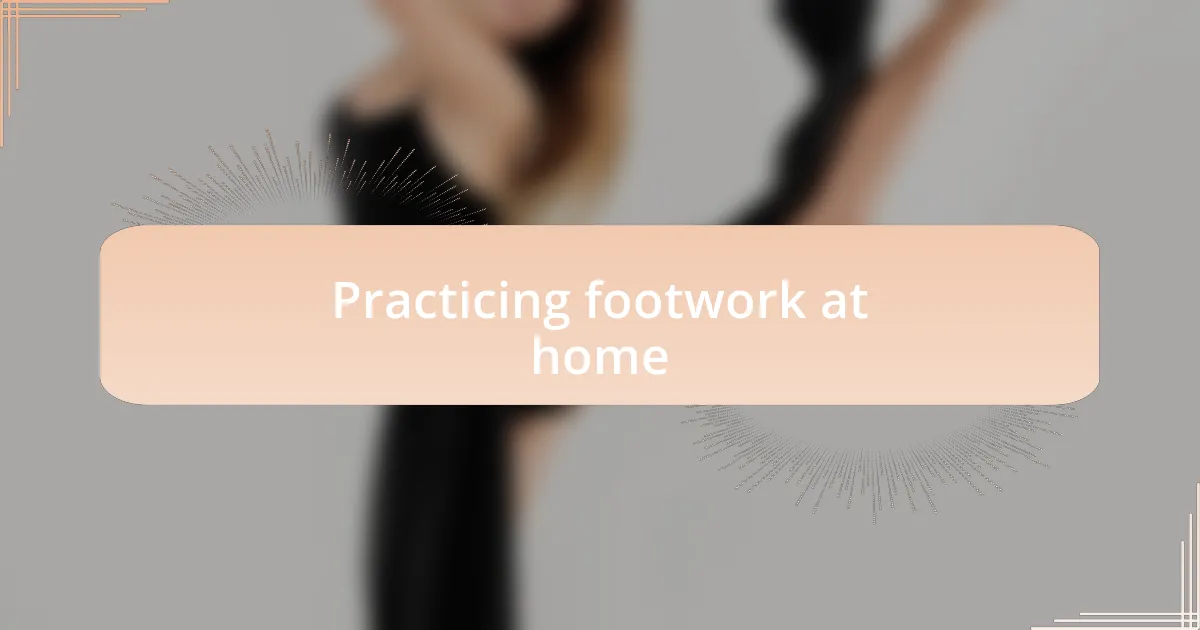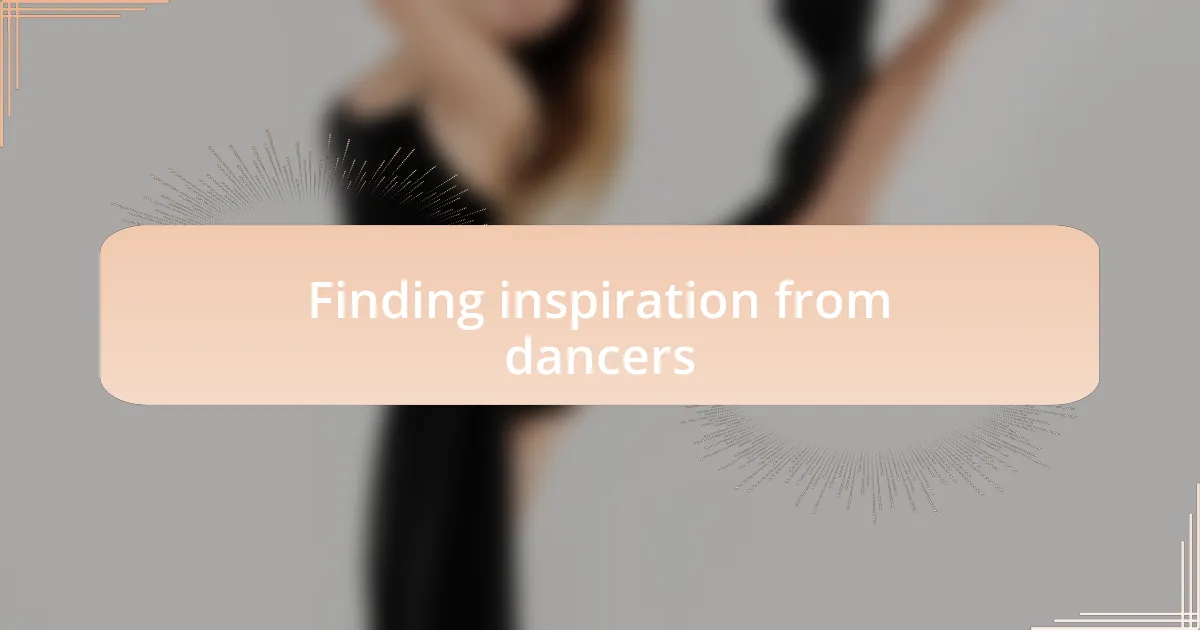Key takeaways:
- Footwork in breakdancing is essential for transitions and creative expression, emphasizing the connection between movement and music.
- Practicing footwork consistently at home, utilizing mirrors, and creating a dedicated space enhances skill and technique refinement.
- Drawing inspiration from other dancers can help develop a personal style while allowing the exchange of techniques and ideas.
- Incorporating music and stepping outside comfort zones during practice fosters improvement and exploration of new dance combinations.

Understanding footwork in breakdancing
Footwork in breakdancing isn’t just about moving your feet; it’s the language of your body. I remember the first time I tried to incorporate footwork into my practice. I felt like I was learning to speak for the first time—there were missteps, but every misstep helped me find my rhythm. Isn’t it fascinating how each move tells a story, and footwork is often the prologue?
One thing that caught me off guard was how crucial footwork is for transitions. Initially, I struggled with connecting different moves fluidly. I often found myself crashing into pauses instead of flowing like water. Then, a mentor pointed out how the right footwork creates a seamless flow in your routines, allowing you to express your creativity without interruption. Have you ever felt stuck because the connection felt off? Trust me, practicing footwork can be the key to unlocking those creative blocks.
As I improved, I discovered that footwork also reflects your unique style. Watching others perform, I noticed how their personal quirks came through their steps. The way I adapted certain moves made them my own, contributing to my identity as a breaker. It made me wonder: how can we all make our footwork a genuine expression of who we are on the dance floor? I believe the answer lies in experimenting and connecting with the music, which really transforms footwork from mere steps into an authentic expression of self.

Importance of footwork in dance
Footwork is the backbone of dance, especially in breakdancing, where every step can either elevate or diminish a performance. I remember being at a jam, captivated by a dancer whose footwork was so sharp that it drew everyone in. It made me realize that strong footwork doesn’t just hold your routine together; it captures attention and evokes emotion. How powerful is that?
In my experience, mastering footwork significantly enhances musicality. When I focus on syncing my steps with the beat, every transition feels more dynamic and alive. It’s as if my body becomes an instrument playing along with the music. Have you ever found yourself lost in the rhythm while dancing? That’s the magic of well-executed footwork—it creates a connection not just to the music but also to the audience.
Moreover, footwork emphasizes the versatility of a dancer. I often experiment with various styles, and I’ve noticed how a simple change in foot placement can shift the entire vibe of a move. Whether it’s adding a twist or incorporating spins, footwork has the ability to showcase different emotions, like joy or intensity. Have you tried adding your unique flair to your footwork? It’s an exciting way to stand out and show the world your creativity.

Common footwork techniques
When it comes to breakdancing, one of the most fundamental footwork techniques is the six-step. I vividly remember the first time I nailed it; the sense of rhythm and flow I experienced was exhilarating. This circular motion creates a solid foundation for transitioning into other moves while maintaining continuous movement—do you recall that feeling of being on a roll during practice?
Another common technique is the freeze, which, though seemingly simple, relies heavily on precise foot placement. I used to struggle with this until I realized that the secret is in establishing a strong base through my feet. It’s fascinating how just a slight adjustment can mean the difference between a clean freeze and a wobbly one—have you ever found that your foot positioning can empower or limit your balance?
Lastly, the top rock stands out as a quintessential footwork technique that sets the tone for your entire set. I’ve often used it to warm up, feeling how it instantly connects my energy with the audience’s. The way you move your feet in this style can convey your attitude, whether it’s playful or fierce. Isn’t it incredible how footwork serves as a reflection of who you are as a dancer?

Practicing footwork at home
Finding space at home to practice footwork can be a game changer. I remember one time when I cleared out my living room to create a mini practice area. The moment my feet hit the floor, I could feel the energy shift; it transformed my living space into a dance haven. Have you ever thought about how much your environment impacts your flow?
Once you have an appropriate space, consistency is key. I started setting aside just 20 minutes a day to focus specifically on footwork drills—whether it’s the six-step or combos that challenge me. Over time, I noticed that dedicating this short, focused time made my body more comfortable with the movements. How often do we underestimate the importance of regular practice?
Incorporating mirrors into your home practice can bring an invaluable perspective to your footwork. I placed a full-length mirror across from my dancing area, which allowed me to see my foot placements and transitions clearly. It’s amazing how visually observing yourself can unlock those little nuances that make your footwork cleaner. Do you have a mirror at home that could help refine your style?

Finding inspiration from dancers
Finding inspiration from other dancers often fuels my creativity and motivates me to push my limits. I recall watching a video of a renowned B-boy who made footwork look effortless. His unique style sparked something in me; it was as if I could feel the rhythm resonating in my own feet, urging me to explore new combinations. Have you ever watched a performance that made you want to jump up and dance immediately?
Every dancer brings their own flair and technique to the table, which can serve as a valuable learning tool. I often find myself studying the footwork of fellow dancers during battles or practice sessions. Seeing how they navigate movement and space not only sparks ideas but also highlights aspects of my own technique that could use refinement. Isn’t it fascinating how watching others can illuminate paths we hadn’t considered before?
It’s not just about imitation; it’s about finding your voice through those inspirations. I’ve learned to infuse elements from dancers I admire into my own movement, crafting a personal style that reflects my journey. Each time I take inspiration from someone else’s footwork, it feels like we’re engaging in a silent conversation, exchanging techniques and ideas. Have you tried blending your favorite moves with your unique twist?

Personal tips for improving footwork
When it comes to improving footwork, I find that consistency is key. I recall dedicating a solid 15 minutes of each practice session just to footwork drills. At first, my feet felt clumsy, but over time, those repetitions transformed my movements into something fluid. Have you experienced that moment when everything suddenly clicks?
Incorporating music into your practice can make a world of difference. I’ve experimented with different beats, and I’ve found that the tempo directly influences how I approach my footwork. I remember dancing to a particularly fast track and pushing myself to match the rhythm, which not only improved my speed but also added flair to my movements. Have you tried dancing to various genres and noticed how they affect your style?
Lastly, don’t shy away from stepping outside your comfort zone. I once tried combining footwork techniques from other dance styles, like tapping or even some elements of salsa. The challenge initially felt intimidating, but the mix led to fresh ideas and exciting new combinations. Isn’t it thrilling to discover how blending styles can open up new avenues in your own dancing?